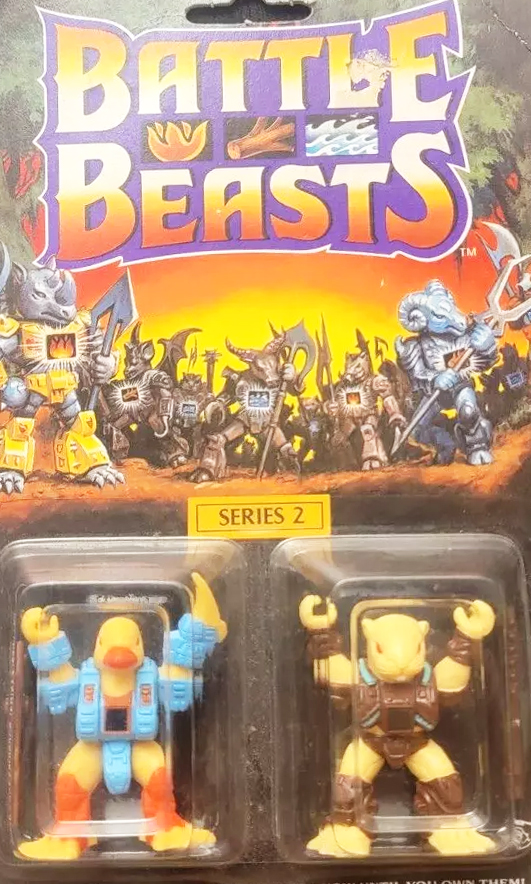In the late 1980s, a pocket-sized army of armored animals stormed the playground: Battle Beasts. Tiny, fierce, and interactive, these 2-inch warriors wore heat-sensitive emblems that revealed their elemental strengths—fire, water, or wood. Short-lived at retail but long-lived in memory, they’ve become a cult favorite of 80s toy culture.
Origins: From Beastformers to Battle Beasts
Developed by Japan’s Takara (the company behind much of Transformers G1), the line debuted in Japan as Beastformers—with lore tied directly to the Transformers universe. When Hasbro brought the concept stateside in 1987, the Transformers link was dropped, but the elemental mechanic remained central to the play pattern.
In fiction, allegiances swirled around three forces: fire, water, and wood. That elemental triangle became the brand’s signature—and the spark for countless schoolyard showdowns.
Figures: Tiny, Armored, and Full of Personality
Standing roughly two inches tall, each figure is an anthropomorphic animal in tech armor with simple arm/leg articulation. The sculpting sells the attitude: snarling faces, plated limbs, and oversized weapons. Over 70 figures reached U.S. shelves, spanning mammals, birds, fish, reptiles, and insects.
Fan-favorite examples
- Pirate Lion — regal mane, eye patch, natural squad leader vibes.
- Bighorn Sheep — heavy horns and a charging stance that looks mid-battle.
- Shark — armored fins and an undersea bruiser silhouette.
- Beetle — exoskeletal plating with “can’t-crack-me” energy.
Weapons ranged from blades and axes to sci-fi blasters, giving each beast a distinct combat style and display silhouette.
Heat-Sensitive Stickers: The Elemental “Game Piece”
Each figure’s chest carried a heat-reactive square—rub to reveal fire, water, or wood. Kids instantly recognized the rock–paper–scissors logic: fire beats wood, wood beats water, water beats fire. The reveal added suspense and replay value, turning the toys into quick dueling game pieces as much as display collectibles.
Vehicles & Playsets: Expanding the Battleground
Beyond singles, the line included a handful of vehicles and playsets: armored tanks, chariots, and robotic mounts. The War Chariot could carry multiple figures and sported detachable weapons—small in footprint but big in table-top drama. Accessories were fewer than in vehicle-centric lines like M.A.S.K., yet they amplified diorama and battle play nicely.
Collectibility: Short Run, Long Tail
The U.S. line wrapped by 1989, but the aftermarket kept the brand alive. Later-wave figures, intact weapons, and original chest stickers in good condition drive premiums today. Japan saw an extended run with additional elements—metal, electricity, ice—broadening the triangle and producing variants prized by international collectors.
- Condition matters: stickers cloud with age and weapons go missing; complete examples command more.
- Watch reproductions: replacement weapons and stickers exist—ask for clear, well-lit photos.
- Display/storage: keep away from heat/sun; use inert clamshells or stands to avoid warping.
Why They Endure
Battle Beasts packed a compelling loop into a tiny figure: recognizable animal identity, bold armor design, and an interactive reveal. They felt like a game you could carry in your pocket. Even without a long TV tie-in, the concept stuck—and resurged in Japan years later as Beast Saga.
Legacy
As a mini-figure line, Battle Beasts sit at the crossroads of 80s trends: character collecting (see Kenner Star Wars), small-scale army building, and tactile play gimmicks (akin to Transformers’ Rubsigns). They remain a compact masterclass in how a simple mechanic plus strong silhouettes can outlive a short retail window.
Also in: 1980s Toys
